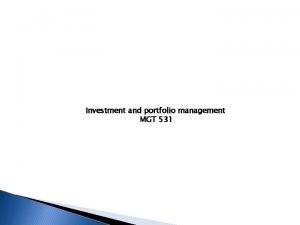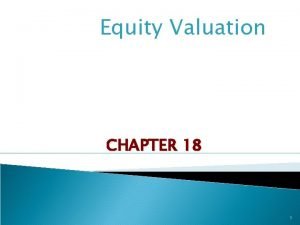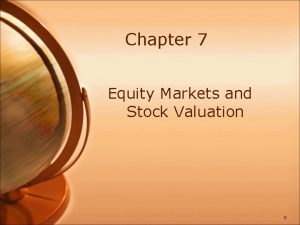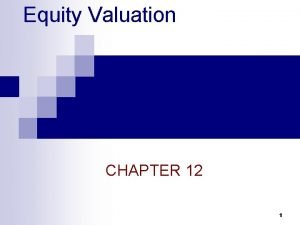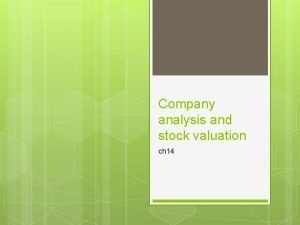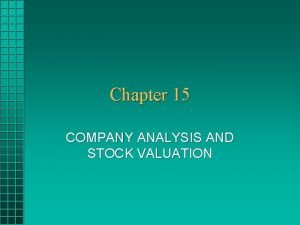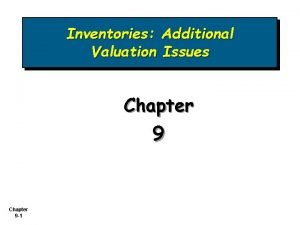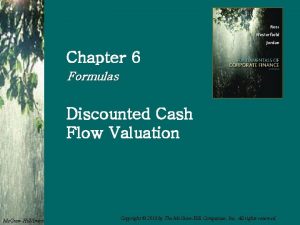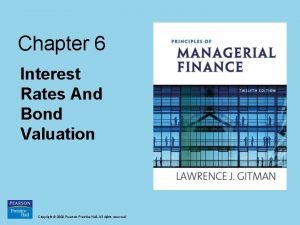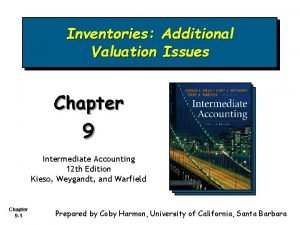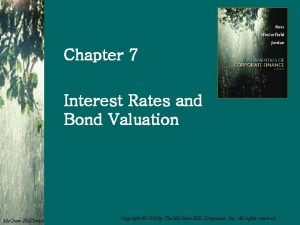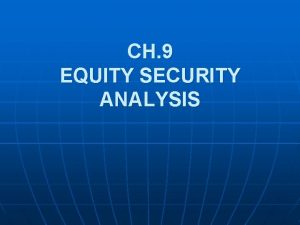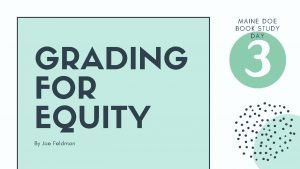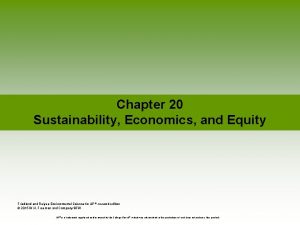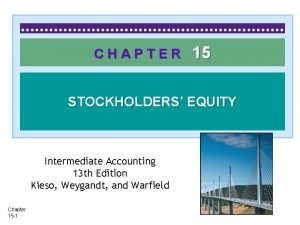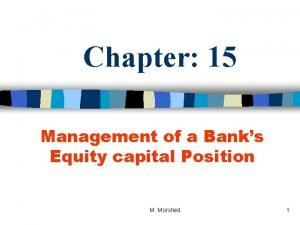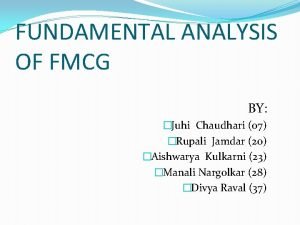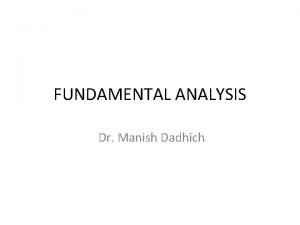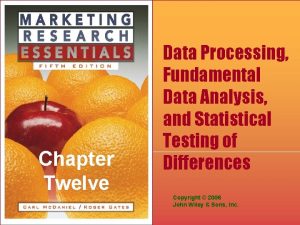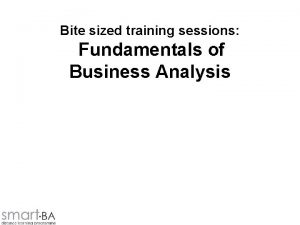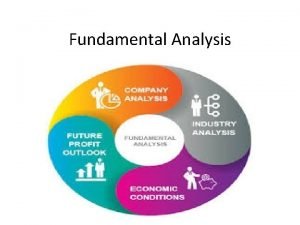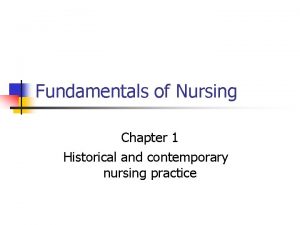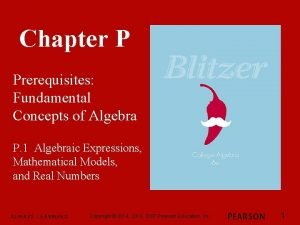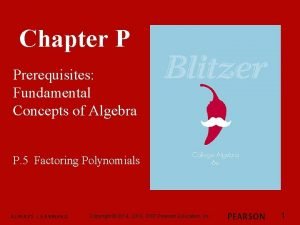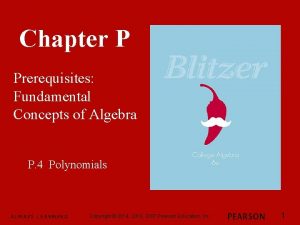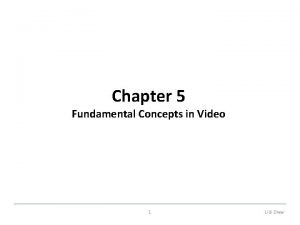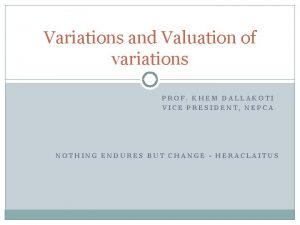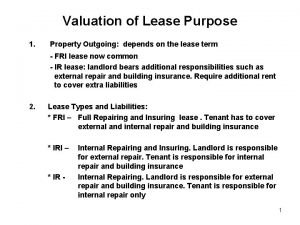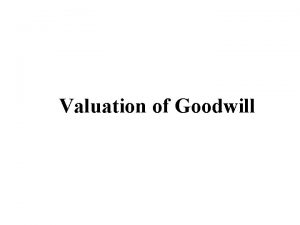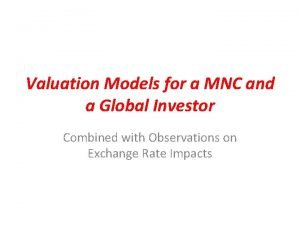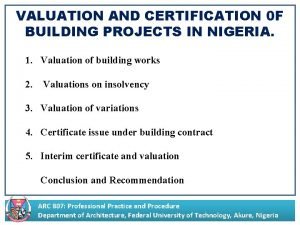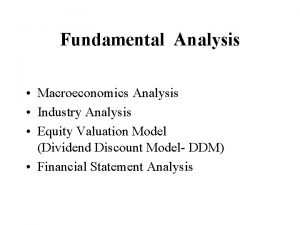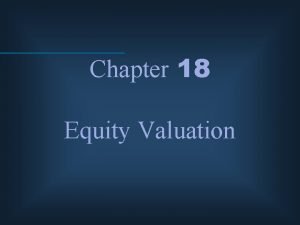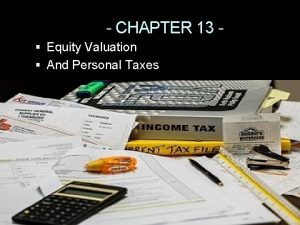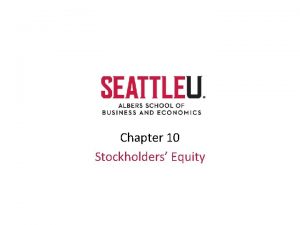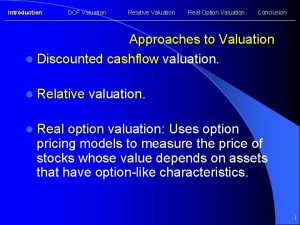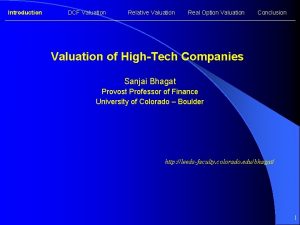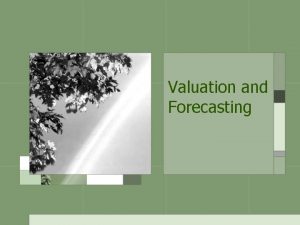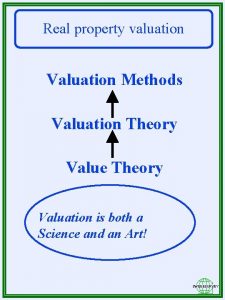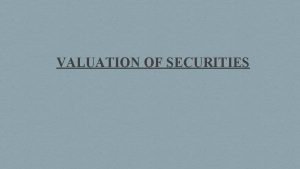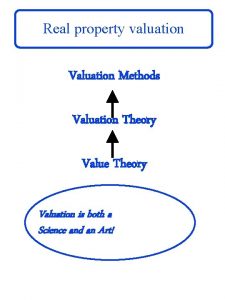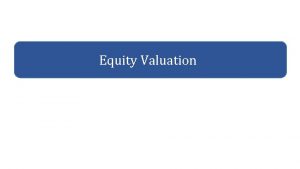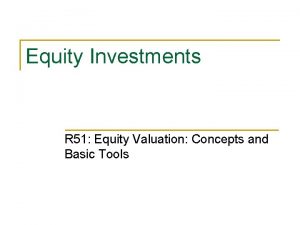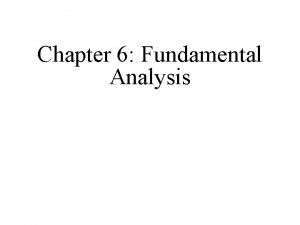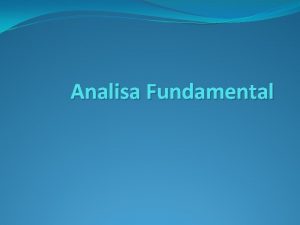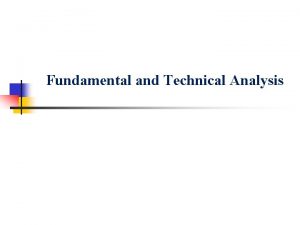Equity Valuation CHAPTER 12 1 Fundamental analysis n






































- Slides: 38

Equity Valuation CHAPTER 12 1

Fundamental analysis n n n Identify stocks that are mispriced relative to true value Compare the actual market price and the true price estimated from various models using publicly available information The true price estimated from models is the intrinsic value (IV) Market price (MP): consensus value of all potential trades (buyers and sellers) Trading signal IV > MP: underpriced, buy ¨ IV < MP: overpriced, sell ¨ IV = MP: fairly priced, hold ¨

Determine underpriced/overpriced stocks (calculate alpha) • If estimated E(r) > Required Return, the stock is undervalued. • If estimated E(r) < required return, the stock is overvalued • required return is from a pricing model, e. g. CAPM:

Determine underpriced/overpriced stocks (calculate alpha) n n example: stock ABC, the current price Po = 48, expected price in 1 year E(P 1) = 52, expected dividend in 1 year E(D 1) = 4 rf = 6, RPm = 5, beta = 1. 2 Is this stock overpriced or underpriced? Step 1: calculate the estimated expected return estimated E(R) = (52+4 -48)/48 = 16. 7% n Step 2: calculate required return from CAPM ¨ n required E(R) = 6 + 1. 2(5) = 12 Step 3: calculate alpha = 16. 7 – 12 = 4. 7 > 0 ¨ stock is undervalued ¨

Determine underpriced/overpriced stocks (calculate intrinsic value) Intrinsic value --The present value of a firm’s expected future net cash flows discounted by the required rate of return. • V 0 (intrinsic value) > P 0 (market price) Þ buy (undervalued) • V 0 (intrinsic (overvalued) • In • k value) < P 0 (market price) Þ sell or sell short market equilibrium, V 0 = P 0 (fairly priced) is required return

Determine underpriced/overpriced stocks (calculate intrinsic value) n Previous example n Vo = 50 > Po = 48, the current market price is undervalued compared with the intrinsic value

Estimate intrinsic value n n Dividend discount model (DDM) P/E ratios approach

Dividend discount model (DDM) Dividend discount model (infinite horizon): the intrinsic value is the present value of all futures dividends discounted by the required return

Dividend discount model (DDM) n No growth model: The same amount of dividend every year (perpetuity) n Example: a preferred stock, D = 5, required return k = 15%. What is the value of this stock ¨ Vo = 5/. 15 = 33. 33

Dividend discount model (DDM): constant growth rate n Constant growth model: dividend grows at a constant rate g

Dividend discount model (DDM): constant growth rate n Example 1: stock ABC, next year dividend = 3, required return k = 15%, constant growth rate = 8%. What is the value of the stock n Example 2: stock ABC, just paid dividend = 0. 50, required return k = 15%, constant growth rate = 2%. What is the value of the stock

Implications of constant growth DDM • If expected dividend D 1 increases, then V 0 increases. • • • If k decreases, then V 0 increases. If g increases, then V 0 increases. Price grows at the same rate as dividend

Implications of constant growth DDM n Required return k: n In equilibrium, the intrinsic value = market price i. e. Vo = Po, therefore, Dividend Yield Capital Gains Yield

Estimate growth rate g n Company A: 2 scenarios No investment opportunities: the expected return of all projects in the company < required return k. In this case, the company would choose to pay 100% of the earning as dividends and let the stockholders invest in the market by themselves ¨ Has investment opportunities: if the company has investment opportunity, expected return of projects is higher than required return k, then the company would choose low dividend payout policy, (a smaller fraction of earning goes to dividend) say ¨ n n 40% dividend (dividend payout ratio) 60% retained earning to be used for reinvestment (plow-back ratio or earning retention ratio)

Dividend Payout Ratio and Plowback Ratio n Dividend Payout Ratio: Percentage of earnings paid out as dividends n Plowback (or Earning Retention) Ratio: Fraction of earnings retained and reinvested in the firm

Estimate growth rate g n n n Company A, total asset 100 mil, all equity financed. ROE = 15%. Total earning = 15% (100) = 15 mil If 60% of earning is reinvested, new additional capital is 60%(15) = 9 mil Old capital = 100, new capital = 9, total capital = 109 Growth rate g is the growth rate in value of capital (stock) ¨ g = (109 -100)/100 = 9%

Plowback Ratio and Growth Where: ROE = Return on Equity b = Plowback Ratio (or Earning Retention Ratio) Example: g = 15% (0. 6) = 9%

Partitioning value n n n n n Example, Company A, expected earning E 1=5, k = 12. 5% No growth: pay all earnings as dividend, D = 5 With growth: ROE = 15%, b = 0. 6 so g = ? No growth: P*0= E 1/k = D/k = 40 with growth: P 0 = D 1/(k-g) = 5(. 4)/(0. 15 -0. 125) = 57. 14 Why the price with growth is higher than the price with no growth? Price (with growth) = P*0 (no growth) + PVGO (present value of growth opportunities) PVGO is reward to growth opportunities 57. 14 = 40 + 17. 14

Partitioning Value: Growth and No Growth Components E 1 + PVGO Vo = k D o (1 + g ) E 1 PVGO = (k - g) k PVGO = Present Value of Growth Opportunities n E 1 = Earnings Per Share for period 1 n

Partitioning Value: Growth and No Growth Components Example: Takeover Target has a dividend payout ratio of 60% and an ROE of 20%. If it expects earnings to be $ 5 per share, the appropriate capitalization rate is 15%? What is the intrinsic value, what is PVGO, what is NGVo?

Partitioning Value: Example n ROE = 20% d = 60% b = 40% n E 1 = $5. 00 D 1 = $3. 00 k = 15% n g =. 20 x. 40 =. 08 or 8%

Partitioning Value: Example 3 = $42. 86 Vo = (. 15 -. 08) 5 = $33. 33 NGV o =. 15 PVGO = $42. 86 - $33. 33 = $9. 52 Vo = value with growth NGVo = no growth component value PVGO = Present Value of Growth Opportunities

Growth opportunity: another example n Takeover Target is run by entrenched management that insists on reinvesting 60% of its earnings in projects that provide an ROE of 10% despite the fact that the firm’s required return k = 15%. The firm’s next year dividend = $2 per share, paid out of earnings of $5 per share. At what price should the firm sell? what is the present value of growth opportunities? Can we increase the firm’s value?

Shifting growth rate model (multistage growth model) n n In constant growth DDM, g is constant over time In practice, there are some periods g is high (when more investment opportunities), some periods g is low (when less investment opportunities)

Shifting growth rate model (multistage growth model) Changing growth rates: temporary high (or low) growth permanent constant growth

Shifting growth rate model (multistage growth model) Example: Whitewater Rapids Company is expected to have dividends grow at a rate of 20% for the next three years. In three years, the dividends will settle down to a more sustainable growth rate of 5% which is expected to last “forever. ” If Whitewater just paid a dividend of $2. 00 and its level of risk requires a discount rate of 15%, what is the intrinsic value of Whitewater stock?

Shifting growth rate model (multistage growth model) n n n Compute the dividends until growth levels off ¨ D 1 = 2(1. 2) = $2. 40 ¨ D 2 = 2. 4(1. 2) = $2. 88 ¨ D 3 = 2. 88(1. 2) = $3. 46 Find the expected future price at the year growth leves off ¨ P 3 = D 3(1+g) / (k – g) = 3. 46(1. 05) / (. 15 -. 05) = 36. 3 Find the intrinsic value which is the present value of the all expected future cash flows ¨ V 0 = 2. 4 / (1. 15) + (2. 88) / (1. 15)2 + (3. 46) / (1. 15)3 + (36. 3) / (1. 15)3 = 30. 40

Price-Earning (P/E) Ratios n n n Ratio of Stock price to its earnings per share Useful for firm valuation: in practice ¨ Forecasts of E ¨ Forecasts of P/E

Price-Earning (P/E) Ratios and growth

P/E Ratio with Constant Growth D 1 E 1(1 - b) = P 0 = k - g k - (b ´ ROE ) P 0 1 - b = E 1 k - (b ´ ROE ) n n b = retention ration ROE = Return on Equity

Price-Earning (P/E) Ratio Plowback ratio (b) (k = 12%) 0 0. 25 A. Growth rate g ROE 10 0 2. 5 12 0 3 14 0 3. 5 B. P/E ratio ROE 10 8. 33 7. 89 12 8. 33 14 8. 33 8. 82 0. 50 0. 75 5 6 7 7. 5 9 10. 5 7. 14 8. 33 10. 00 5. 56 8. 33 16. 67

Some comments with P/E Ratios n High plowback ratio (b) = ROE*b) High Growth Rate (g) (g BUT n High g (if due to high b) n higher b High P/E ratio higher P/E only when ROE > k

P/E ratio and Risk Holding everything equal: High risk (k), Low P/E.

P/E ratios in practice n n P/E ratio proxies for expected growth in dividends or earnings. If the stock is correctly priced, the rule of thumb is P/E ≈ g or PEG ≈ 1 ¨ PEG > 1 then overpriced ¨ PEG < 1 then underpriced ¨ PEG: no theoretical explanation but works very well ¨ n Peter Lynch, the famous portfolio manager, said in this book One Up on Wall Street The P/E ratio of any company that is fairly priced will equal its growth rate. I am talking here about growth rate of earnings. . If the P/E ratio of Coca. Cola is 15, you’d expect the company to be growing at 15% per year, etc. But if the P/E ratio is less than the growth rate, you may have found yourself a bargain.

Pitfalls in P/E Analysis • Earnings are based on accounting data Current price and current earnings Future expected earnings is more appropriate • In P/E formula, E is an expected trend • • In financial pages, E is the actual past period's earnings Different accounting methods will give different earnings

Other Valuation Ratios & Approaches n Price-to-book: price per share/book value per share ¨ How aggressively the market values the firm Price-to-cash flow: price per share/cash flow per share n Price-to-sales: price per share/sales per share n ¨ Some start-up firms do not have earnings so sale is more appropriate. n Be creative: depending on particular situation to design your own ratio


Summary Valuation approaches: -Balance sheet values (P/E ratio) -Present value of expected future dividends • DDM states that the price of a share of stock is equal to the present value of all future dividends discounted at the appropriate required rate of return • Constant growth model DDM: • • P/E ratio is an indication of the firm's future growth opportunities
 Equity analysis and valuation
Equity analysis and valuation Equity analysis
Equity analysis Valuation of fixed income securities
Valuation of fixed income securities Equity valuation definition
Equity valuation definition Equity markets and stock valuation
Equity markets and stock valuation Equity valuation ppt
Equity valuation ppt Equity valuation formula
Equity valuation formula Company analysis stock valuation
Company analysis stock valuation Company analysis and stock valuation
Company analysis and stock valuation Chapter 7 interest rates and bond valuation
Chapter 7 interest rates and bond valuation Chapter 9 inventories additional valuation issues
Chapter 9 inventories additional valuation issues Chapter 6 discounted cash flow valuation
Chapter 6 discounted cash flow valuation How to find the price of a bond
How to find the price of a bond Chapter 6 interest rates and bond valuation
Chapter 6 interest rates and bond valuation Chapter 9 inventories additional valuation issues
Chapter 9 inventories additional valuation issues Chapter 7 interest rates and bond valuation
Chapter 7 interest rates and bond valuation Chapter 6 interest rates and bond valuation
Chapter 6 interest rates and bond valuation Equity security analysis
Equity security analysis Grading for equity powerpoint
Grading for equity powerpoint Contoh soal ekuitas pemegang saham
Contoh soal ekuitas pemegang saham Apes chapter 20 sustainability economics and equity
Apes chapter 20 sustainability economics and equity Chapter 15 intermediate accounting
Chapter 15 intermediate accounting Chapter 15 debt and equity capital
Chapter 15 debt and equity capital Fundamental analysis of fmcg sector
Fundamental analysis of fmcg sector Eic approach of fundamental analysis
Eic approach of fundamental analysis Twelve data
Twelve data Fundamental of business analysis
Fundamental of business analysis Fundamental analysis meaning
Fundamental analysis meaning Fundamental of nursing chapter 1
Fundamental of nursing chapter 1 Chapter p prerequisites: fundamental concepts of algebra
Chapter p prerequisites: fundamental concepts of algebra Chapter p prerequisites fundamental concepts of algebra
Chapter p prerequisites fundamental concepts of algebra Chapter p prerequisites
Chapter p prerequisites Fundamental concepts in video
Fundamental concepts in video Valuation of variations
Valuation of variations Plant and machinery valuation
Plant and machinery valuation What is outgoing in valuation
What is outgoing in valuation Goodwill calculation
Goodwill calculation Mnc se
Mnc se Building valuation certificate
Building valuation certificate
